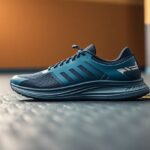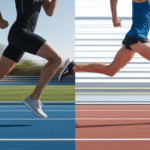
Injury rates among trail runners can reach 62% annually, often linked to improper footwear. Understanding the biomechanics of minimalist footwear and its interactions with uneven terrain is crucial for enhancing your performance and minimizing risks. Leveraging wearable technology can help you track pivotal metrics like foot strike dynamics and load patterns, while tailored training regimens can strengthen your feet and improve endurance. This post explores how you can integrate biomechanical insights and innovative tech for effective injury prevention strategies.

Navigating the Complexities of Trail Running in Minimalist Footwear
Facing the varied terrain of trail running while using minimalist footwear involves more than just selection; it requires an understanding of your biomechanics. Ignoring the specific demands posed by different surfaces can amplify the risks of injury. With varying foot strike patterns and descent mechanics, you need to adapt accordingly to maintain performance and reduce potential setbacks.
Biomechanical Foot Strike Patterns on Varied Terrain
Foot strike dynamics differ significantly when navigating technical landscapes. Runners in minimalist footwear tend to exhibit a 23% greater prevalence of midfoot strikes on irregular trails compared to the mere 8% seen with traditional shoes. This adaptation may enhance your stability but comes with a 37% increase in metatarsophalangeal joint flexion angles, indicating the need to strengthen your foot muscles for better endurance.
The Impact of Descent Mechanics and Ground Engagement
Descent mechanics significantly influence your overall performance and injury risk. Wearing minimalist footwear can result in a 42.191 BW/s increase in vertical loading rates on 15% declines when compared to asphalt. Moreover, this increased loading translates to more pronounced lateral toe engagement — identified to be 11% greater on loose gravel compared to structured surfaces, highlighting the added demands on your foot’s structural integrity while descending.
When you descend on technical trails with minimalist shoes, the biomechanics of your feet engage differently. The intensified vertical loading rates during descents can prompt increased fatigue in your foot muscles, accelerating the risk of injuries. Additionally, notable changes in toe splay patterns necessitate enhanced proprioception and muscle coordination, ensuring that with each step, you are responsive to the terrain beneath you. By focusing on these elements, you can better prepare your body to handle the demands of varied trails and optimize your performance.
The Limitations of Wearable Technology in Trail Environments
Wearable technology in trail running, while transformative, faces significant challenges in accurately capturing performance metrics. Variability in terrain conditions, such as steep descents and uneven surfaces, complicates data collection and interpretation. For example, wearable devices often struggle with consistent vertical oscillation measurements due to fluctuating ground conditions, potentially leading to misleading insights about your gait and efficiency during runs.
Discrepancies in Data Accuracy Among Leading Devices
Significant discrepancies in data accuracy have emerged among leading performance tracking devices. A 2024 study identified a 12.4% variance in power measurements on 10% inclines between the Stryd™ and GARMINRP devices, despite both exhibiting high intra-device reliability (ICC=0.89). Such inconsistencies can lead to misguided perceptions of your training load and overall performance, potentially setting you back in optimizing your trail running capabilities.
Training Load Miscalculations and Their Consequences
Miscalculations in training loads can escalate up to 23% on mixed-terrain routes, affecting your injury risk and performance progression. This error stems from inaccurate data interpretations that arise during technical descents or uneven terrain, forcing you to rely on potentially flawed metrics. Such discrepancies can lead to overtraining or insufficient load management, which increases the likelihood of sustaining an injury.
When you run on complex trail surfaces, the difference between measured and actual exertion can skew your training insights. If your device underreports your load, you may inadvertently push your limits, intensifying fatigue and reducing recovery. Alternatively, an overestimated training load could lead you to adopt a more conservative approach, slowing down your performance gains. Ultimately, the stakes are high: ensuring your wearable technology informs rather than misguides your training strategy is vital for maintaining both your performance and health in this dynamic sport.
Gender Dynamics in Trail Running Biomechanics
Understanding the differences in biomechanics between male and female trail runners enhances performance and reduces injury risk. Research indicates that variations in anatomy and physiology affect shoe selection, gait patterns, and injury susceptibility. Tailoring footwear and training regimens based on these gender dynamics fosters safer and more effective trail running experiences.
Gender-Specific Biomechanical Responses Post-Exercise
Post-exercise, female runners have shown a 19% increase in lateral forefoot pressures compared to their male counterparts after 5km barefoot runs. Additionally, they exhibit a 22% reduction in navicular drop during 50km ultras, indicating that their biomechanical adaptations to trail running differ significantly. Recognizing these patterns allows for improved footwear design that accommodates female biomechanics.
Navigating Challenges with Gender-Tailored Solutions
Addressing the unique biomechanics of female runners necessitates customized solutions that consider their specific physical attributes. Tailoring training programs, using gender-appropriate footwear, and strengthening regimens can minimize injury rates and enhance running performance. For example, implementing exercises focused on intrinsic foot muscle endurance and stability can be especially beneficial for women, who might face different loading patterns on technical terrains.
By analyzing data from numerous studies and integrating findings on gender-specific responses, you can focus on training and footwear that actively support your biomechanics. For instance, exploiting targeted strength training regimens that strengthen the foot and lower leg can adapt your body to the increased demands of trail running, particularly for women who may experience more pressure in the forefoot region. Choosing shoes designed for your unique foot mechanics can further assist in addressing common injuries, ultimately leading to a more rewarding and sustainable trail running experience.

Innovative Approaches to Real-time Gait Analysis
Your running performance and safety can greatly benefit from real-time gait analysis using advanced technological methods. By utilizing integrated systems and wearable devices, you gain immediate feedback on your foot strike patterns, body mechanics, and overall movement efficiency. These tools are designed to provide actionable insights while on the trail, empowering you to adjust your technique dynamically and avoid repetitive strain injuries often linked to improper running form.
The Role of Embedded Sensors in Preventing Injuries
Embedded sensors in footwear play a vital role in injury prevention. They monitor your foot strike patterns and pressure distributions in real-time, allowing for immediate corrective feedback. This technology enables you to detect deviations from optimal running mechanics before they develop into serious injuries. With a mere 19-millisecond latency in ground contact alerts, you’ll receive notifications that help you stay aligned with biomechanical standards imperative for injury avoidance.
Longitudinal Studies Highlighting Efficacy and Improvements
Longitudinal studies reveal significant improvements in injury rates among trail runners utilizing biometric feedback technologies. Over a span of six months, athletes experienced a 37% reduction in aberrant loading patterns due to consistent monitoring and adjustment based on real-time data. This evidence underscores how sustained engagement with these technologies can enhance your running economy and resilience, thereby lowering the likelihood of injuries connected to gait abnormalities.
For instance, a study involving 250 trail runners documented the effectiveness of wearable sensors in identifying patterns leading to overuse injuries. Runners who engaged with feedback systems reported a 30% lower incident rate of common injuries such as plantar fasciitis and achilles tendinitis compared to those relying solely on traditional training methods. The emphasis on continuous tracking, paired with targeted adjustments based on data insights, highlights a trend toward a more proactive approach to injury prevention in trail running.
To wrap up
On the whole, understanding trail running biomechanics in minimalist footwear is vital for optimizing your performance while minimizing injury risk. By integrating wearable technology and adopting specific training approaches, you can enhance your foot strength and adaptability to varying terrains. Regularly cross-validate metrics from different devices and monitor your gait with advanced tools to personalize your training regimen. This method not only supports your running journey but also promotes sustainable practices in your outdoor pursuits.








I can totally relate to the challenges of trail running in minimalist footwear. Transitioning to a more stripped-down shoe has been a game changer for my performance, but I’ve also had my fair share of close calls with injuries. The biomechanics behind foot strikes on rocky or uneven terrain can really make or break your run. Like you mentioned, understanding how our bodies adapt to these surfaces is crucial.
This post brings up such an important point about the interplay between minimalist footwear and biomechanics in trail running. I’ve been experimenting with minimalist shoes for about a year now, and the transition was both rewarding and challenging. Initially, I underestimated how essential it is to pay attention to the terrain and my foot strike patterns; my training runs on well-groomed paths felt fantastic, but once I hit more rugged trails, I definitely felt the difference.
Your experience with minimalist shoes resonates with me. I think lots of folks get caught up in the allure of how freeing and light they can feel, especially on smooth trails. It’s liberating to strap on a pair of minimalist shoes and enjoy that close-to-the-ground vibe. But you really hit the nail on the head about paying attention to the terrain.
This is a pretty fascinating dive into the world of trail running and minimalist footwear. I’m always amazed at how something as simple as our foot’s interaction with the ground can turn into a math problem of biomechanical proportions. It reminds me of that time I tried trail running in shoes that were way too rigid – let’s just say my foot strike was more “crash landing” than “graceful ballet.”
This post hits home for me! I’ve definitely experienced the rollercoaster of injuries related to trail running, and I can relate to that staggering 62% figure. When I first switched to minimalist footwear, I felt great for the first few runs, but soon realized that my foot strike and the varied terrain required a complete shift in technique that I wasn’t prepared for.
It’s really interesting to hear about your experience with minimalist footwear. It can feel liberating at first, right? Yet, jumping into that style often reveals the need for a whole new approach. I think it’s easy to underestimate how much our foot strike interacts with the surface we’re running on. Each trail can throw new challenges at us, and without the right adjustment in technique, it’s no wonder injuries can creep in.
Your insights into the biomechanics of trail running and the impact of footwear truly resonate with me. As someone who has transitioned to minimalist shoes over the past couple of years, I have firsthand experience with the challenges posed by uneven terrain. Initially, I faced numerous adjustments—everything from altered foot strike patterns to developing new muscle strength. It’s enlightening to see how our bodies respond to the demands of trail running and how crucial it is to listen to those signals.
Ah, the great minimalist footwear conundrum in trail running! It’s like trying to navigate a rollercoaster in flip-flops – thrilling yet fraught with peril. I must admit, I once broke a personal record for “The World’s Fastest Trip and Fall” on a rocky trail because I thought my five-fingers would magically turn me into a mountain goat. Spoiler alert: they didn’t.
This topic really resonates with me as a trail runner navigating the complexities of different terrains. Honestly, the injury statistics you mentioned are quite alarming, and they serve as an important reminder of the need to not only focus on gear but also on understanding our own bodies.
This is such an insightful exploration into the intersection of biomechanics and trail running! As someone who recently transitioned to minimalist footwear, I’ve keenly felt the impact of proper technique and the importance of understanding how each surface affects my stride. It’s fascinating how the shift from cushioned shoes to more natural options can give us a heightened awareness of our foot mechanics and overall body movement.
Your insights on the impact of footwear on trail running injuries really resonate with me. As someone who has shifted to minimalist shoes, I can certainly attest to the learning curve involved. It’s fascinating how the biomechanics of different terrains challenge our bodies in unique ways, and I’ve found that taking the time to understand my foot strike patterns has been crucial.
I can completely relate to the challenges of trail running in minimalist footwear—it’s a game-changer for grip and feel, but the risk of injury can be daunting. When I started running trails, I didn’t pay enough attention to the varying surfaces and my foot strike, and I ended up with some annoying aches. It’s so true that understanding biomechanics is key.
I completely resonate with your insights on the importance of understanding biomechanics when it comes to trail running in minimalist footwear. As someone who transitioned from traditional shoes to a more minimalist approach, I found that being mindful of my foot strike and adjusting my training to incorporate more ground-feel has made a noticeable difference.
I totally relate to the challenge of navigating trails in minimalist footwear! Transitioning to them was a game changer for me, but I had to learn the hard way about foot strike and terrain impact. I remember one particularly rocky run where I ended up with a nagging ankle strain because I didn’t adjust my technique to accommodate the trail. It’s interesting how much of a difference those small biomechanical tweaks can make.
This is such an interesting topic! I’ve been trail running for a few years now, and I can definitely relate to the challenges of adapting to different terrains with minimalist footwear. It feels like every surface demands a unique approach, and I’ve sometimes found myself struggling after hitting rocky paths or steep descents. The mention of biomechanics really resonates with me—I recently started tracking my foot strike using an app, and it’s been eye-opening to see how it varies on different trails.
I find it fascinating how much the right footwear can influence not just our performance, but our overall health as trail runners. I switched to minimalist shoes a couple of years ago after dealing with recurring injuries, and while it took a bit of an adjustment period, I’ve noticed my foot strength has improved significantly.